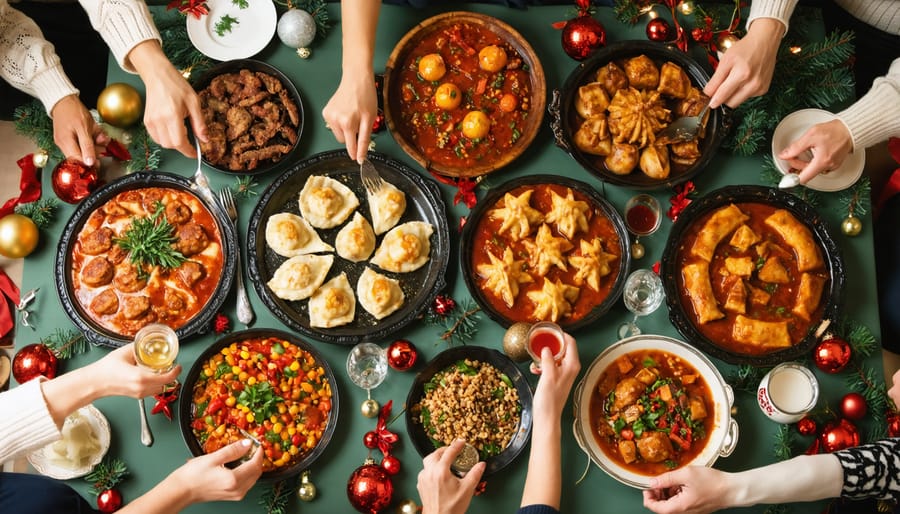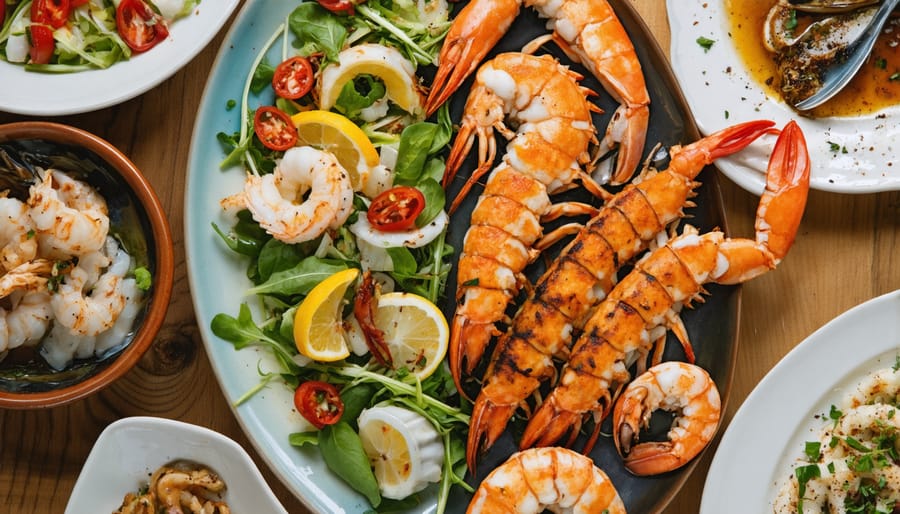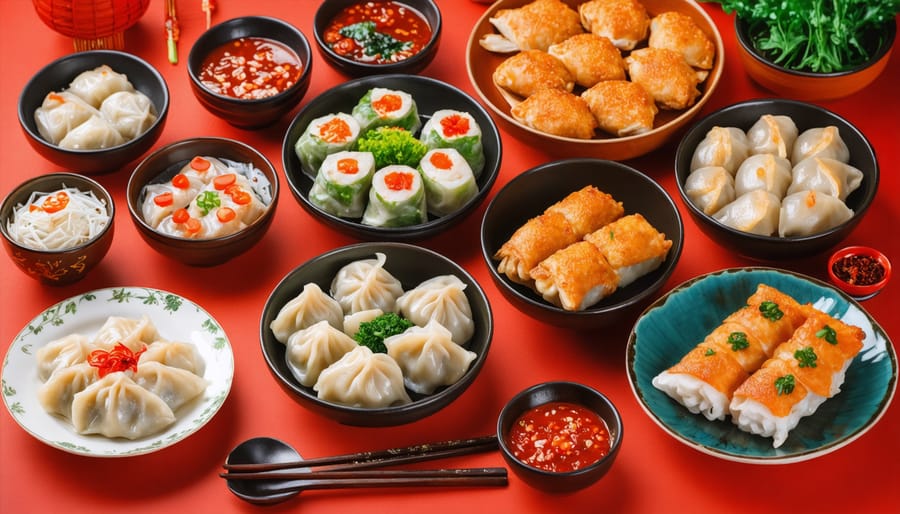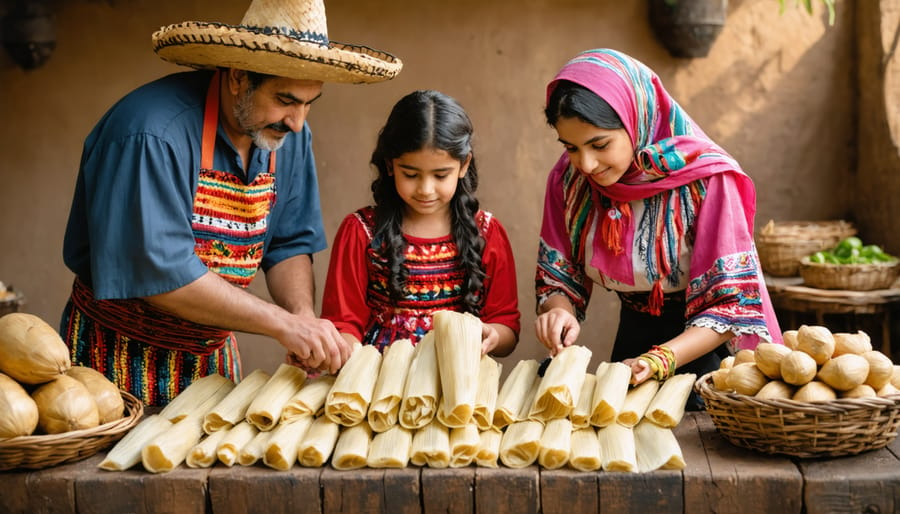
Gather around a global feast this holiday season as we journey through kitchens from Morocco to Malaysia, discovering how different cultures celebrate their most cherished occasions through food. Beyond the familiar turkey and ham, there’s a world of festive dishes waiting to transform your holiday table – each recipe carrying centuries of tradition and love. Whether you’re exploring your own heritage or seeking to create new holiday table decorating ideas inspired by international flavors, these time-honored recipes offer a delicious way to connect with celebrations around the world. From the aromatic spices of Indian Biryani served during Diwali to the comforting warmth of Swedish Glögg shared on cold Christmas evenings, these dishes tell stories of family, tradition, and the universal language of food that brings us all together during the holidays.
European Holiday Delights
Italian Christmas Eve Feast
The enchanting Italian Christmas Eve tradition of the Feast of the Seven Fishes transforms dinner into a magical celebration of seafood and family. As someone who married into an Italian-American family, I’ve come to cherish this beautiful custom that fills our home with the aromatic blend of garlic, herbs, and fresh seafood every December 24th.
The feast traditionally features seven different seafood dishes, though some families serve up to thirteen! Our table always includes tender baccalà (salt cod) in a rich tomato sauce, perfectly seared scallops with lemon and herbs, and my mother-in-law’s famous linguine with clam sauce that has everyone asking for seconds.
Other classic dishes you might find include crispy fried calamari, Mediterranean-style whole roasted branzino, octopus salad, and shrimp scampi. Each dish represents the Catholic tradition of abstaining from meat on Christmas Eve, though you don’t need to be religious to appreciate this incredible feast.
What makes this tradition truly special isn’t just the food – it’s the way it brings everyone together in the kitchen. There’s something heartwarming about watching three generations work side by side, sharing stories and techniques passed down through the years. Whether you’re Italian or not, incorporating even just a few of these seafood dishes into your holiday celebration can create a memorable and delicious new tradition.

German Christmas Markets at Home
Transform your kitchen into a charming German Christmas market with these beloved holiday treats! I’ll never forget my first taste of Lebkuchen – those wonderfully spiced honey cookies that perfectly capture the magic of the season. These soft, chewy delights are easier to make at home than you might think, featuring a warming blend of cinnamon, nutmeg, and candied citrus peel.
No German Christmas market experience would be complete without Glühwein, one of my favorite festive holiday drinks. This soul-warming mulled wine combines red wine with orange slices, cinnamon sticks, and star anise, creating an aromatic beverage that’ll make your home smell absolutely heavenly.
For the perfect market-style setup, arrange your Lebkuchen on a rustic wooden board and serve your Glühwein in traditional ceramic mugs. Add some twinkling lights and evergreen branches, and you’ll capture that cozy German Christmas market atmosphere right in your own home. Don’t forget to make extra Lebkuchen – these spice-filled cookies make wonderful gifts, and trust me, your friends will be asking for more!
Pro tip: While both treats are delicious on their own, they’re absolutely magical when enjoyed together. The subtle sweetness of the Lebkuchen perfectly complements the warm, spiced notes of the Glühwein.
Asian Holiday Traditions
Chinese New Year Essentials
The Lunar New Year celebration is filled with meaningful traditions, and none are more delightful than the lucky foods that grace every Chinese family’s table. Having celebrated many New Year feasts with my dear friend Lin and her family, I’ve learned that each dish carries a special symbolism for prosperity and good fortune in the year ahead.
Dumplings, shaped like ancient Chinese gold ingots, are essential for attracting wealth. I love watching Lin’s grandmother expertly fold each one, sometimes hiding a coin inside for extra luck! Long, uncut noodles symbolize longevity – the longer the noodle, the longer the life. Just remember to slurp them whole!
Whole fish is another must-have, served with the head and tail intact to represent a prosperous beginning and end to the year. The Mandarin word for fish (yú) sounds like the word for surplus, making it doubly auspicious. Sweet rice balls (tang yuan) in warm syrup symbolize family unity and completeness, while oranges and tangerines are displayed everywhere because their golden color represents wealth.
Spring rolls, crispy and golden brown, look like gold bars and are believed to bring prosperity. My personal favorite is the “prosperity toss” or yee sang – a colorful raw fish salad where everyone tosses the ingredients high with chopsticks while shouting good wishes. The higher you toss, the more prosperity you’ll attract!

Japanese New Year Classics
When I first discovered Osechi Ryori, I was captivated by how each dish carries a special meaning for the year ahead. These traditional Japanese New Year delicacies aren’t just about sustenance; they’re edible wishes for prosperity, happiness, and good fortune.
The cornerstone of any Osechi selection is kuromame (sweet black soybeans), symbolizing health and diligence for the coming year. Alongside these, you’ll find kazunoko (herring roe), representing fertility and family prosperity – a stunning addition to the array of Japanese seafood dishes in the celebration.
One of my favorite elements is the kobumaki (rolled kelp), which represents joy and happiness. The datemaki (sweet rolled omelet) adds a touch of sophistication and scholarship to your wishes for the new year. For those seeking good fortune, the golden-colored kurikinton (mashed sweet potatoes with chestnuts) represents wealth and financial success.
Don’t forget the tazukuri (dried sardines candied in soy sauce) – these tiny fish symbolize an abundant harvest. While preparing these dishes takes time and patience, the joy of sharing these meaningful foods with loved ones makes it all worthwhile. Modern families often mix store-bought items with homemade dishes, proving that traditions can adapt while keeping their heart intact.
Latin American Celebrations

Mexican Christmas Favorites
There’s something magical about gathering with family to make tamales during the holiday season – a tradition I learned to cherish after spending Christmas with my neighbor Rosa’s family. These corn-based parcels wrapped in corn husks are more than just food; they’re a celebration of family and tradition.
Traditional Mexican tamales start with masa (corn dough) that’s whipped until light and fluffy, then filled with savory meats, cheese, or even sweet ingredients. The most popular Christmas variety features shredded pork in red chile sauce, though chicken and beef versions are equally delicious. What makes this dish special is the assembly line of family members, each with their designated task, sharing stories and laughter as they work.
No Mexican Christmas would be complete without ponche navideño, a warm, fruity punch that fills the house with an irresistible aroma. This comforting beverage combines fresh and dried fruits like tejocotes (Mexican hawthorn), guavas, and apples, along with aromatic cinnamon sticks and piloncillo (unrefined cane sugar). As it simmers, the fruits release their natural sweetness, creating a perfectly balanced drink that warms both body and soul.
Pro tip: Make extra tamales to freeze – they reheat beautifully and make perfect quick meals throughout the winter months. For the ponche, feel free to substitute tejocotes with crabapples if you can’t find them at your local Mexican market.
Brazilian New Year Traditions
As someone who’s had the joy of experiencing Reveillon firsthand, I can tell you that Brazilian New Year celebrations are a feast for all the senses! The traditional spread always includes lentils for prosperity, with a gorgeous lentil and rice dish called Arroz com Lentilhas taking center stage. The aromatic combination of garlic, bay leaves, and fresh herbs makes this dish irresistible.
No Brazilian New Year’s table is complete without the classic Chester (a special type of roasted poultry) served alongside farofa, a toasted manioc flour mixture that adds a delightfully crunchy texture. For good luck, Brazilians serve seven different fruits, with pomegranate being particularly special – tradition says counting the seeds brings wealth for the year ahead!
One of my favorite traditions is serving whole fish, often cod prepared as Bacalhau à Gomes de Sá, symbolizing abundance in the coming year. The dish combines layers of potatoes, onions, and flaked cod, all drizzled with olive oil and garnished with black olives and fresh parsley.
For dessert, the table sparkles with rabanada, Brazil’s answer to French toast, dusted with cinnamon sugar and drizzled with honey. Everything is traditionally served after midnight, accompanied by champagne and white clothing – symbolizing peace and new beginnings for the year ahead.
Modern Fusion Holiday Menu
As someone who loves bringing people together through food, I’ve discovered that some of the most memorable holiday meals happen when we dare to mix traditions. Creating festive twists on holiday dishes has become my favorite way to celebrate our increasingly connected world.
Let’s start with appetizers: imagine combining Chinese spring roll wrappers with traditional Christmas stuffing ingredients, creating crispy “Christmas Spring Rolls” served with cranberry sweet chili sauce. Or try serving classic latkes topped with Greek tzatziki and pomegranate seeds – a beautiful fusion that honors multiple traditions while creating something entirely new.
For main courses, consider a tamale-inspired turkey, where the traditional holiday bird is rubbed with Mexican adobo seasonings and served alongside masa dumplings. Another crowd-pleaser is the “Mediterranean Christmas Pasta,” which combines Italian pasta with Middle Eastern spices and traditional holiday ingredients like chestnuts and sage.
Side dishes offer endless possibilities for creative fusion. Korean-style Brussels sprouts with gochujang and honey bring an unexpected kick to the holiday table, while Indian-spiced roasted root vegetables with curry leaves and mustard seeds transform familiar winter vegetables into something extraordinary.
One of my favorite fusion desserts is the “Holiday Tiramisu,” where I replace the traditional coffee flavor with chai spices and add crushed gingerbread cookies between the layers. Another winner is the “Mochi Christmas Cookies,” combining Japanese mochi texture with classic holiday flavors like peppermint and chocolate.
When creating fusion holiday dishes, remember these simple guidelines:
– Start with familiar flavors and gradually introduce new elements
– Keep at least one traditional element that guests can recognize
– Consider texture combinations as much as flavors
– Don’t be afraid to experiment with different cooking techniques
The key to successful fusion cooking is respecting the original cultures while creating something that brings joy to your table. Remember, these modern interpretations aren’t about replacing traditions – they’re about creating new ones that reflect our diverse communities and connections.
As we wrap up our culinary journey around the world, it’s amazing to think about how holiday foods connect us all, even across vast distances and different cultures. Each recipe we’ve explored carries generations of stories, family gatherings, and cherished memories. Whether it’s the warming spices of German Lebkuchen, the delicate layers of French Bûche de Noël, or the comforting aroma of Mexican tamales, these dishes remind us that celebrating with food is a universal language of love and tradition.
I’m always touched by how sharing these recipes with friends and family creates new traditions while honoring old ones. Just last year, my neighbor brought Swedish pepparkakor to our holiday potluck, and now they’ve become a must-have at my own family’s celebration. That’s the beauty of exploring holiday foods from around the world – they have a way of becoming part of our own story.
I encourage you to step outside your comfort zone this holiday season. Try making that traditional Italian panettone you’ve always admired, or surprise your guests with a plate of Norwegian krumkaker. Don’t worry about getting everything perfect – it’s the joy of creating and sharing that matters most. After all, every holiday tradition started with someone brave enough to try something new.
Remember, when we open our kitchens to new recipes, we open our hearts to understanding different cultures and creating connections that span the globe. Here’s to making this holiday season your most delicious adventure yet!



